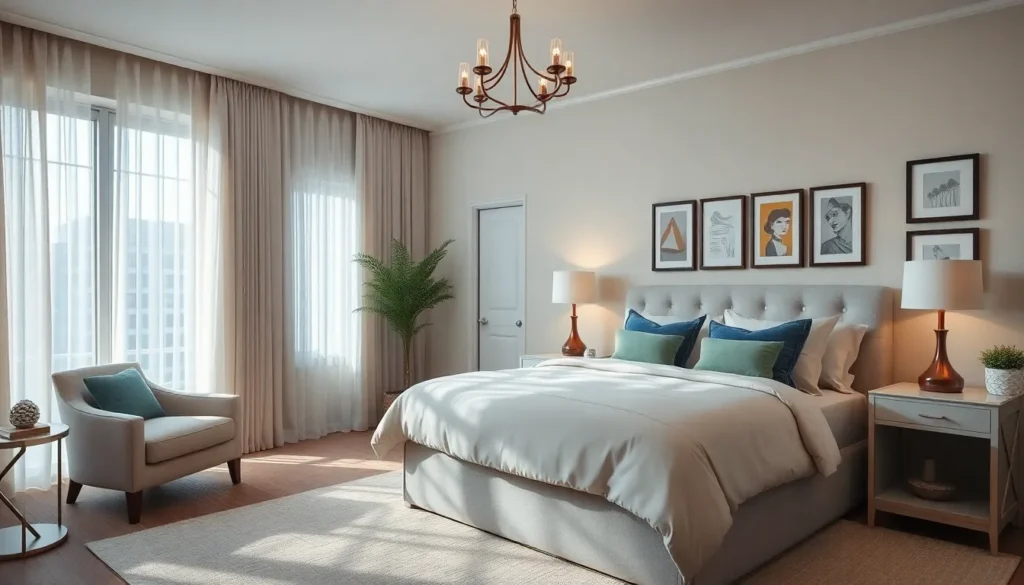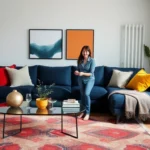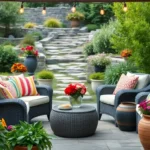We spend roughly a third of our lives in our bedrooms yet many of us treat this sacred space as an afterthought. Your master bedroom should be more than just a place to crash at night – it’s your personal sanctuary where you recharge and reconnect.
Creating the perfect master bedroom doesn’t require a massive budget or complete renovation. Sometimes the smallest changes make the biggest impact. From choosing the right color palette to maximizing storage without sacrificing style we’ve discovered countless ways to transform any bedroom into a luxurious retreat.
Whether you’re working with a spacious suite or a cozy nook we’ll show you how to design a master bedroom that reflects your personality while promoting better sleep and relaxation. Get ready to turn your bedroom into the peaceful haven you’ve always dreamed of.
Create a Luxurious Master Bedroom Retreat With These Color Palette Ideas
The right color scheme transforms your bedroom from ordinary to extraordinary. Color choices directly impact mood, sleep quality, and the overall atmosphere of your personal retreat.
Embrace Neutral Tones for Timeless Elegance
Neutral colors create the foundation for a sophisticated master bedroom that never goes out of style. Warm beiges, soft grays, and creamy whites work together to establish a calming atmosphere that promotes relaxation. These versatile shades allow you to layer textures through bedding, curtains, and furniture without overwhelming the space.
Consider pairing warm taupe walls with crisp white trim and natural linen bedding for an effortlessly elegant look. Off-white paint colors like Benjamin Moore’s Cloud White or Sherwin Williams’ Alabaster provide the perfect backdrop for both modern and traditional bedroom furniture. Rich cream tones add warmth while maintaining the serene quality that makes neutral palettes so appealing for master bedroom design.
Add Drama With Bold Accent Walls
Accent walls bring visual interest and personality to your master bedroom without overwhelming the entire space. Deep navy blue, charcoal gray, or forest green create striking focal points behind the headboard while maintaining a restful atmosphere. These darker shades make white and light-colored bedding pop dramatically.
Textured wallpaper in metallic tones adds luxury and depth to accent walls without requiring bold colors. Consider grasscloth wallpaper in soft gold or subtle geometric patterns in muted tones for sophisticated drama. Paint techniques like color washing or sponging create visual texture that catches light beautifully throughout the day.
Incorporate Calming Blues and Greens for Better Sleep
Blue and green hues naturally promote relaxation and better sleep quality according to color psychology research. Soft powder blue walls paired with white trim create a spa-like atmosphere that encourages rest and rejuvenation. Sage green offers earthy tranquility while maintaining the fresh feeling that makes bedrooms feel inviting.
Deeper shades like dusty teal or muted seafoam work beautifully as accent colors through throw pillows, artwork, or a cozy reading chair. These nature-inspired colors pair perfectly with natural wood furniture and organic textures like jute rugs or bamboo window treatments. Layer different shades of the same color family to create depth while maintaining the peaceful quality essential for quality sleep.
Transform Your Space With Strategic Master Bedroom Lighting Solutions

Beyond color palettes and storage answers, lighting serves as the foundation that brings our bedroom design together. Strategic lighting creates the perfect ambiance while addressing our practical needs throughout the day.
Layer Ambient, Task, and Accent Lighting
Layering three distinct types of lighting transforms our master bedroom from a basic sleeping space into a sophisticated retreat. Ambient lighting provides the foundation with overall room illumination through ceiling fixtures like flush mounts or elegant floor lamps positioned in corners. Task lighting delivers focused brightness exactly where we need it most, featuring reading lamps on nightstands or adjustable wall fixtures for exact activities. Accent lighting adds the finishing touch by highlighting our favorite artwork, architectural details, or decorative elements with spotlights or LED strips.
Creating this three layer system allows us to adjust the mood and functionality throughout our daily routines. We can dim the ambient lighting for relaxation while keeping task lighting bright for reading, then switch to soft accent lighting for intimate conversations.
Install Statement Chandeliers or Pendant Lights
Statement lighting fixtures elevate our bedroom’s sophistication while serving as stunning artistic centerpieces that command attention. Grand chandeliers with crystal elements or brass finishes create an opulent focal point above our bed, instantly transforming the space into a luxury suite. Oversized pendant lights offer a modern alternative, especially those featuring sculptural designs with unique geometric shapes or organic curves.
These dramatic fixtures work best in bedrooms with high ceilings, typically 9 feet or taller, ensuring adequate clearance above the bed. We recommend positioning chandeliers at least 7 feet from the floor to prevent any safety concerns while maintaining their visual impact.
Add Bedside Sconces for Reading Comfort
Bedside sconces provide the perfect task lighting solution for our evening reading routine while freeing up valuable nightstand space. Wall mounted fixtures eliminate the need for bulky table lamps, creating cleaner lines and more surface area for our books, water glasses, or decorative items. Adjustable sconces with swing arms offer maximum flexibility, allowing us to direct light precisely where we need it.
Installing sconces at the proper height ensures optimal reading comfort, with the bottom of the fixture positioned 24 to 27 inches above the mattress. We can choose from various styles, from sleek modern designs with brushed metal finishes to traditional options featuring fabric shades that complement our bedroom’s overall aesthetic.
Maximize Storage While Maintaining Style in Your Master Bedroom
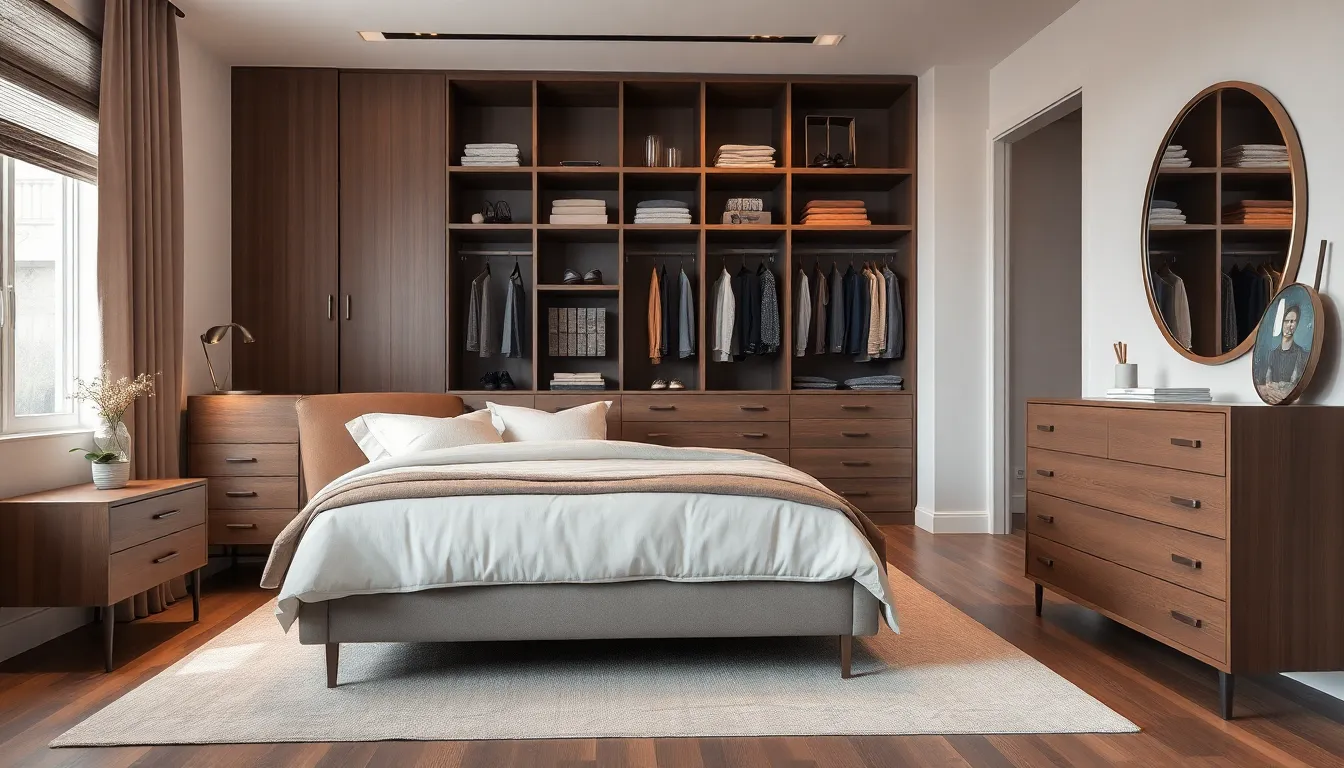
Storage answers don’t have to sacrifice style for functionality. We can create organized spaces that enhance our bedroom’s aesthetic while keeping everything in its place.
Build Custom Walk-in Closets
Custom walk-in closets represent the gold standard for master bedroom storage organization. These personalized spaces offer ample room for hanging clothes, folding garments, and displaying shoes and accessories in an organized manner.
Modular systems like the IKEA BOAXEL wardrobe series provide flexibility and can be adjusted to fit any space configuration. These systems deliver a customized appearance while offering adaptable storage capacity that grows with our needs.
Built-in drawers, adjustable shelving, and pull-out racks enhance accessibility and create better organization systems. Custom options allow us to design exact zones for different clothing types, seasonal items, and personal accessories.
Wall-mounted answers within closets maximize vertical space while maintaining clean lines. These installations create additional storage without overwhelming the room’s visual flow.
Incorporate Under-bed Storage Answers
Under-bed storage transforms wasted space into valuable organizational real estate. This practical approach works especially well in smaller bedrooms where every square foot counts.
Rolling bins slide easily in and out, providing quick access to stored items while maintaining bedroom tidiness. These containers work perfectly for seasonal clothing, extra linens, or rarely used items.
Drawers built into bed frames offer seamless integration with existing furniture pieces. These answers keep storage hidden while maintaining the room’s clean aesthetic lines.
Vacuum-sealed storage bags compress bulky items like comforters and winter clothing into compact packages. These space-saving answers protect fabrics while maximizing storage efficiency under the bed.
Add Stylish Dressers and Armoires
Dressers and armoires remain essential components for comprehensive master bedroom storage systems. Contemporary designs feature clean lines, natural materials, and soft-close drawers that blend functionality with modern style preferences.
Wardrobe systems combine hanging space with integrated shelving and drawer compartments. These versatile pieces offer flexible storage options while providing a finished, cohesive look throughout the bedroom.
Standalone armoires serve as statement pieces that anchor the room’s design while providing substantial storage capacity. These furniture pieces work particularly well in bedrooms without built-in closet space.
Floating shelves and built-in cabinetry create storage answers that appear to be part of the room’s architecture. These installations maintain visual flow while providing dedicated spaces for books, decorative items, and personal belongings.
Design the Perfect Master Bedroom Layout for Optimal Flow
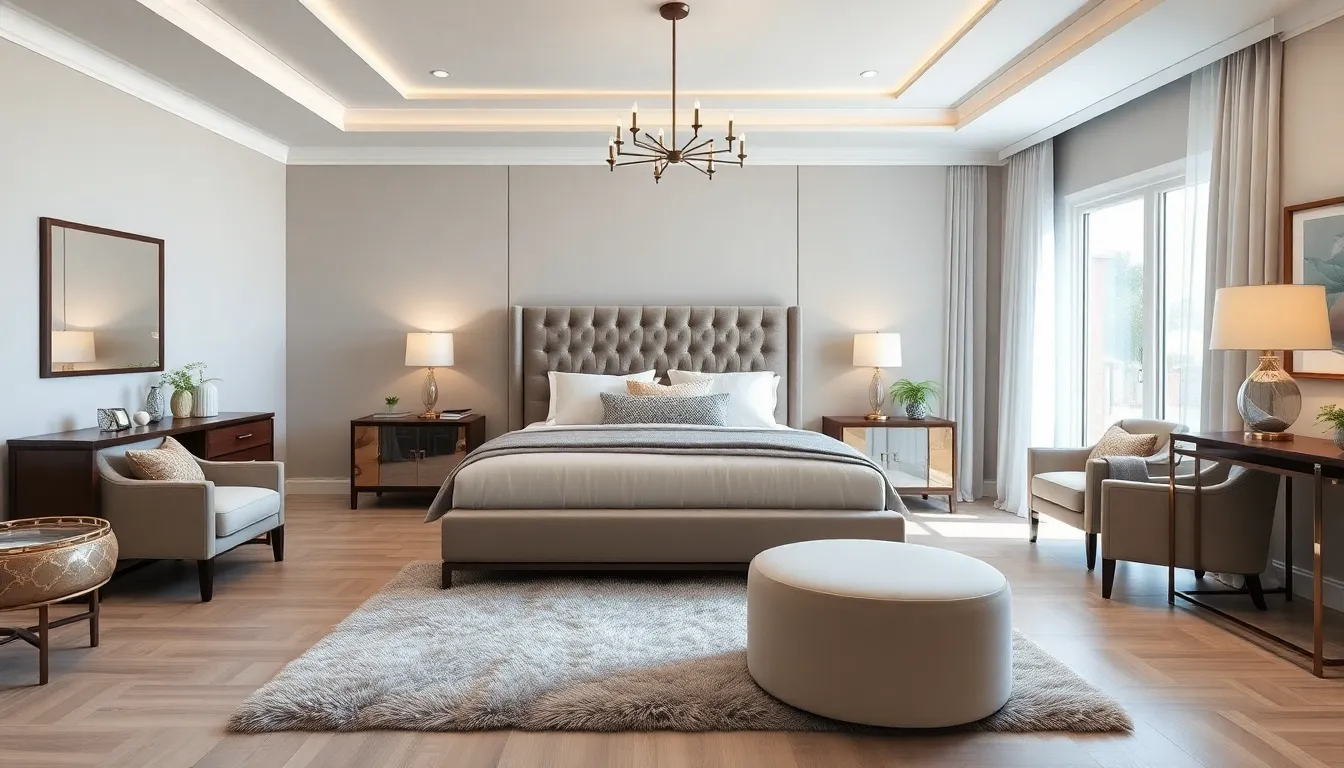
Creating an effective master bedroom layout transforms your space into a harmonious retreat where every element works together seamlessly. We’ll explore strategic placement techniques that maximize both functionality and visual appeal.
Position Your Bed as the Focal Point
Anchor your room with a statement bed frame that commands attention and establishes visual hierarchy. Canopy beds and large statement headboards serve as natural focal points that draw the eye immediately upon entering the space. We recommend placing your bed centrally when space allows, creating a balanced composition that feels intentional and grand.
Flank your bed with matching nightstands to achieve perfect symmetry and enhance functionality. This classic arrangement provides essential storage while maintaining visual balance on both sides of your sleeping area. Position nightstands at mattress height or slightly lower to create clean sight lines and easy access to bedside essentials.
Consider your room’s architectural features when determining bed placement to maximize natural light and views. French doors and bay windows should influence your positioning decisions, ensuring your bed arrangement doesn’t obstruct these beautiful elements. We’ve found that angling beds slightly toward windows can create more ever-changing layouts in uniquely shaped rooms.
Create Separate Zones for Sleep and Relaxation
Establish distinct activity areas within your master bedroom to maximize functionality and create purposeful spaces. Large master bedrooms benefit from dedicated zones that serve different needs throughout the day. We recommend keeping your main sleeping area separate from relaxation and dressing zones to maintain clear boundaries.
Add comfortable seating areas such as chaise lounges, armchairs, or loveseats to create intimate spaces for reading and unwinding. Position these pieces away from the bed area to establish clear separation between sleep and leisure activities. Choose seating that complements your bed’s style while serving as functional accent pieces.
Use area rugs strategically to define each zone visually while maintaining overall cohesion throughout the room. Different rug sizes and placements help distinguish between sleeping areas and seating zones without creating visual chaos. We suggest using complementary colors or patterns that tie your zones together while marking their distinct purposes.
Ensure Proper Traffic Patterns Around Furniture
Maintain at least 24 inches of clearance around each piece of furniture to ensure comfortable movement throughout your master bedroom. This standard measurement prevents cramped pathways and allows for easy navigation during daily routines. We prioritize clear walkways along the foot of the bed and around major furniture pieces to avoid congestion.
Keep doors and windows unobstructed by positioning large furnishings away from these essential access points. Traffic flow becomes compromised when dressers, wardrobes, or seating blocks natural pathways or architectural features. We recommend mapping your room’s circulation patterns before finalizing furniture placement.
Position storage pieces for accessibility without interfering with movement between your sleep and relaxation zones. Dressers and wardrobes should be easily accessible but shouldn’t create barriers in your bedroom’s flow. Consider your room’s architectural elements when placing storage furniture to maintain clear sight lines and maximize natural light distribution.
Choose the Right Master Bedroom Furniture for Comfort and Function
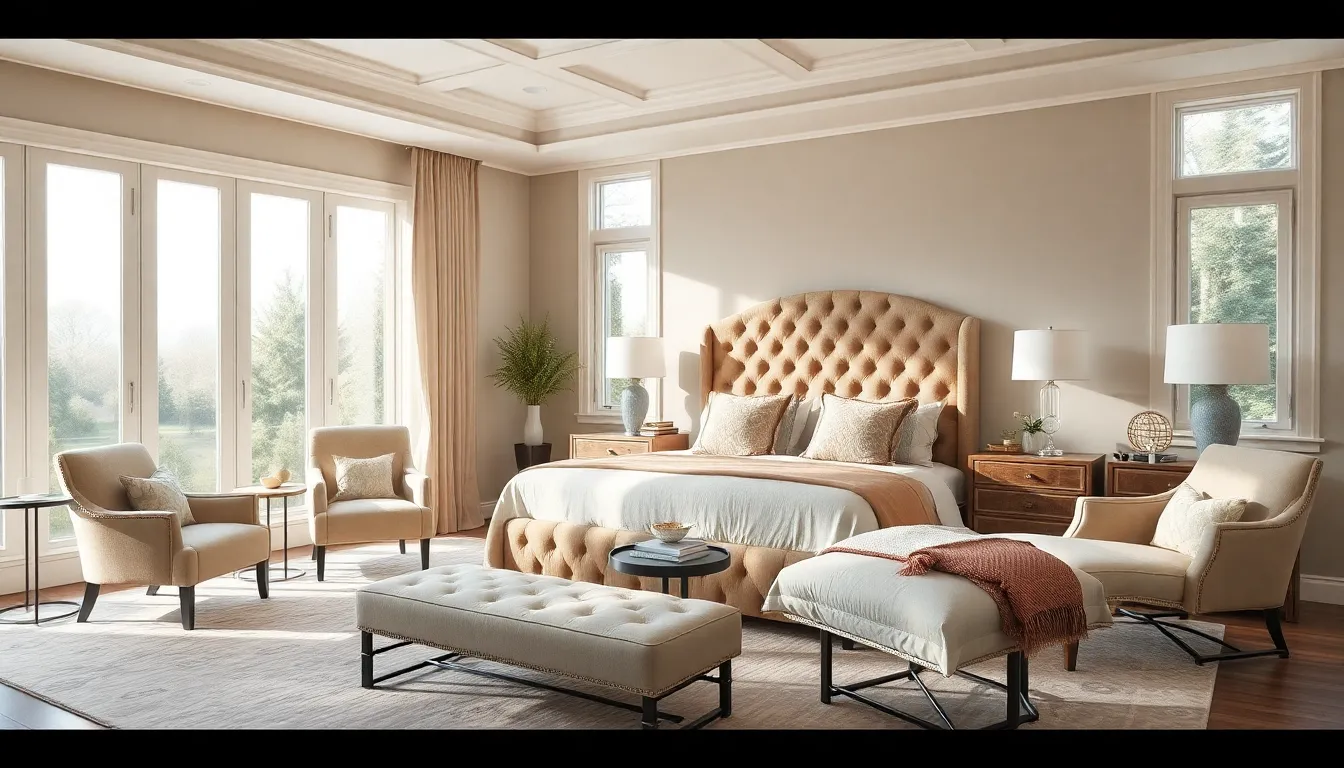
We’ve established the foundation with color, lighting, and storage answers. Now let’s focus on selecting furniture pieces that’ll transform your space into the ultimate comfort zone.
Select the Perfect King or Queen Size Bed Frame
Choosing a king or queen size bed frame ensures your bedroom meets both comfort and proportion requirements. We recommend measuring your room carefully to determine which size works best for your space dimensions.
Consider a freestanding headboard for rooms with ample square footage, as this creates a dramatic focal point while establishing a “room-within-a-room” atmosphere. Freestanding headboards work particularly well when you position the bed in the center of large master bedrooms.
Match your bed frame to your room’s architectural style and existing furniture pieces. Traditional rooms benefit from upholstered headboards in neutral fabrics, while modern spaces shine with sleek metal or wood frames.
Position your bed frame away from high-traffic areas to maintain smooth flow throughout the room. We suggest placing it where it won’t obstruct door swings or block natural light from windows.
Add Comfortable Seating Areas
Create a bench at the foot of your bed to provide convenient seating while getting dressed or putting on shoes. This practical addition doubles as storage when you choose ottomans or benches with built-in compartments.
Establish a mini sitting area with two comfortable chairs, especially near windows where natural light creates an inviting reading nook. These seating options work best when positioned to take advantage of views or architectural features.
Include a chaise lounge if your room dimensions allow, as this provides a luxurious spot for relaxation that doesn’t compete with your bed’s prominence. Chaise lounges work particularly well in corners or alongside windows.
Position seating strategically to create separate zones within your master bedroom. We recommend using area rugs to visually define these spaces and establish clear boundaries between sleeping and relaxation areas.
Include Functional Nightstands and Side Tables
Install matching bedside tables to create visual symmetry and balance in your bedroom design. Matching nightstands provide essential storage while maintaining the harmonious aesthetic you’ve worked to achieve.
Choose nightstands with storage that accommodate your daily essentials like books, charging cables, and personal items. We prefer pieces with at least one drawer and an open shelf for maximum functionality.
Ensure proper proportions by selecting nightstands that align with your mattress height or fall slightly below it. This creates comfortable access to stored items while maintaining clean sight lines across your bed.
Add side tables in seating areas to provide surfaces for beverages, reading materials, and decorative elements. These pieces should complement your nightstands while serving the exact needs of your relaxation zones.
Incorporate Textiles and Fabrics That Elevate Your Master Bedroom Design
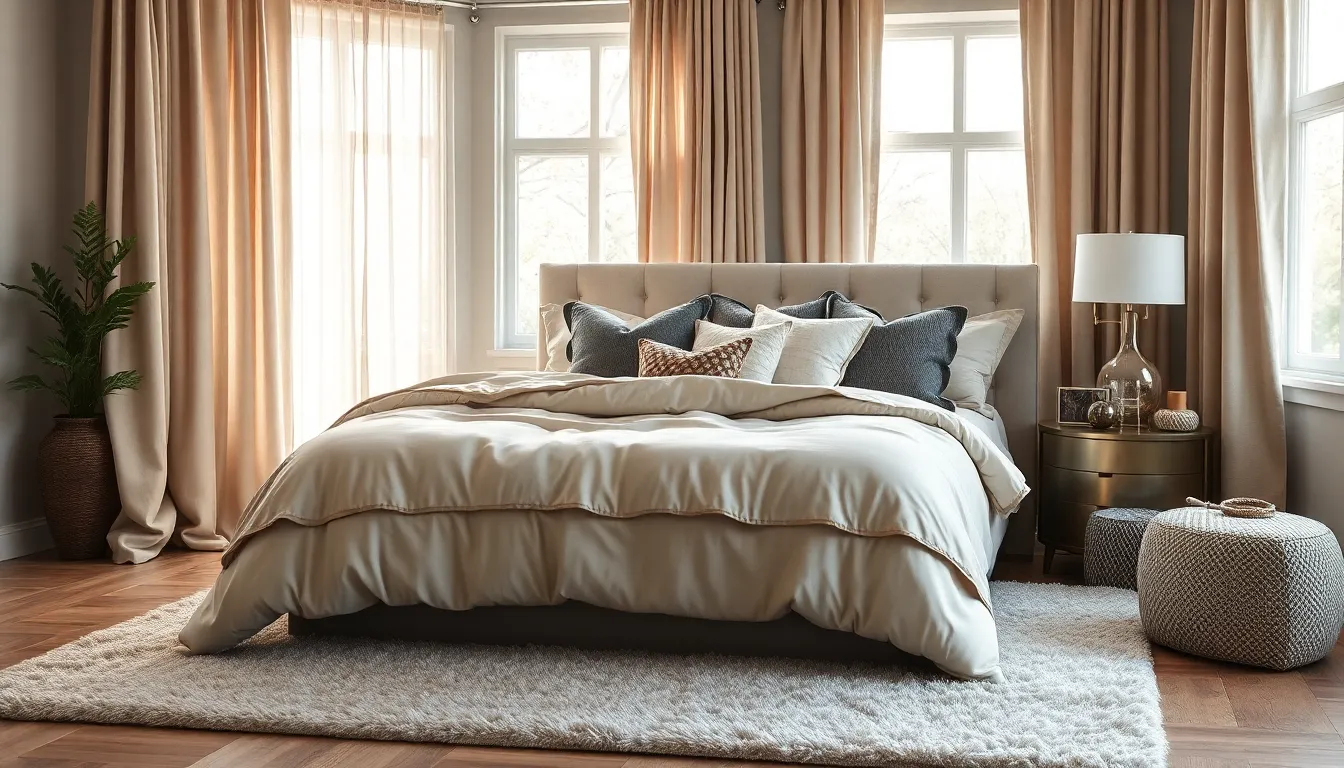
Transforming your master bedroom into a luxurious retreat starts with selecting the right textiles and fabrics. High-quality materials like velvet, linen, tweed, and silk create depth and visual interest while reinforcing your cohesive design scheme.
Layer Different Textures Through Bedding
Layering diverse textures through your bedding adds warmth and dimension that makes the space feel indulgent and inviting. Combine quilted coverlets with cable knit throws and smooth pillow shams to create a tactile experience that’s both stylish and comfortable. Mix jacquard or tweed fabrics with knit or velvet materials to achieve visual depth while maintaining sophistication.
Multiple pillows and throws don’t just look luxurious—they allow for easy customization as seasons change. Stack different sized pillows with varying textures to create visual hierarchy on your bed. Choose fabrics in the same color family but with varied tones to contribute to a calming yet sophisticated atmosphere.
Add Curtains or Drapes for Privacy and Style
Curtains or drapes in coordinating fabrics enhance privacy while completing your room’s aesthetic appeal. Match window treatments to your bedding for a cohesive look, or introduce contrasting patterns that tie the entire room together. This approach makes your space feel polished and intentionally designed.
Light filtering through textured or layered drapes adds to the cozy ambiance while maintaining the sophisticated feel you’re creating. Consider hanging curtains closer to the ceiling and extending them beyond the window frame to make your windows appear larger and more dramatic.
Include Area Rugs to Define Spaces
Area rugs anchor your bed area and help define the space, making large rooms feel cozier while adding comfort underfoot. Soft, plush rugs or patterned carpets add warmth and help unify various design elements throughout your room. Position rugs strategically to create visual boundaries between your sleeping area and other zones like seating or dressing areas.
Choose rugs that complement your textile palette while providing enough coverage to ground your furniture arrangement. We recommend selecting rugs large enough to extend at least 18 inches beyond each side of your bed for proper proportional balance.
Add Personal Touches With Master Bedroom Decor and Accessories
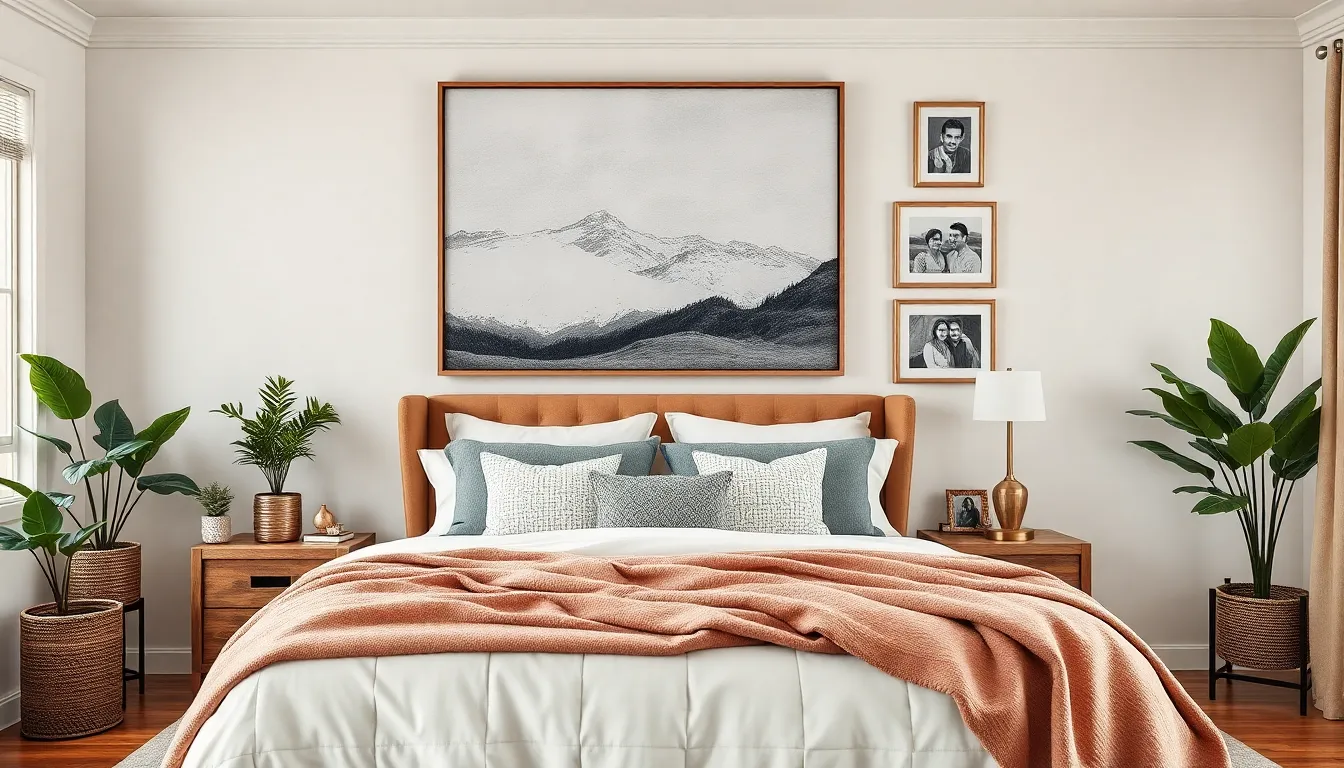
Creating a personalized sanctuary involves carefully selecting decorative elements that reflect your unique style and personality. We’ll explore how strategic accessories can transform your master bedroom into a truly meaningful space.
Display Meaningful Artwork and Photography
Artwork serves as the visual centerpiece that defines your bedroom’s character and emotional tone. We recommend hanging family photos or pieces that resonate with your personal aesthetic to create an intimate atmosphere. Gallery walls work exceptionally well above headboards, allowing you to showcase multiple pieces while maintaining visual balance.
Consider the scale and proportion when selecting artwork for your master bedroom walls. Large statement pieces can anchor the space and draw the eye upward, while smaller collections create visual interest through variety. Professional photography, abstract paintings, or even your own creative works can serve as conversation starters and daily inspiration.
Lighting plays a crucial role in highlighting your chosen artwork effectively. Picture lights or strategically placed accent lighting can illuminate your displays and create depth throughout the room. Frame selections should complement your existing decor while allowing the artwork itself to remain the focal point.
Incorporate Plants for Natural Beauty
Plants bring life and freshness to master bedrooms while improving air quality and creating a calming environment. We suggest choosing low maintenance varieties like ferns or peace lilies that thrive in bedroom conditions and require minimal care. These natural elements add organic texture and color that complements any decorating style.
Consider the lighting conditions in your bedroom when selecting plant varieties for optimal growth. Snake plants and pothos work well in lower light situations, while fiddle leaf figs prefer brighter spaces near windows. Hanging planters can maximize floor space while adding vertical interest to your room design.
Decorative planters and pots become part of your overall aesthetic when chosen thoughtfully. Ceramic vessels, woven baskets, or modern geometric containers can enhance your bedroom’s style while housing your green companions. Group plants of varying heights and textures to create ever-changing visual arrangements that feel naturally curated.
Add Decorative Pillows and Throws
Pillows and throws offer the perfect opportunity to introduce color, pattern, and texture while maintaining flexibility in your design scheme. We recommend using coordinating pillows that tie into your room’s existing color palette while adding visual depth through varying sizes and shapes. Mix different textures like velvet, linen, and faux fur to create tactile interest.
Seasonal updates become effortless when you build a foundation of neutral bedding and accent with changeable accessories. Lightweight cotton throws work beautifully in warmer months, while heavier wool or cashmere options provide cozy warmth during cooler seasons. Layer multiple throws across the foot of your bed or drape them over seating areas for instant comfort.
Color coordination doesn’t mean everything must match perfectly in your accessory selections. Choose a cohesive palette that includes your room’s primary colors while introducing complementary shades through your pillow and throw combinations. This approach creates visual harmony while preventing the space from feeling too rigid or overly coordinated.
Create a Spa-Like Master Bedroom Experience at Home
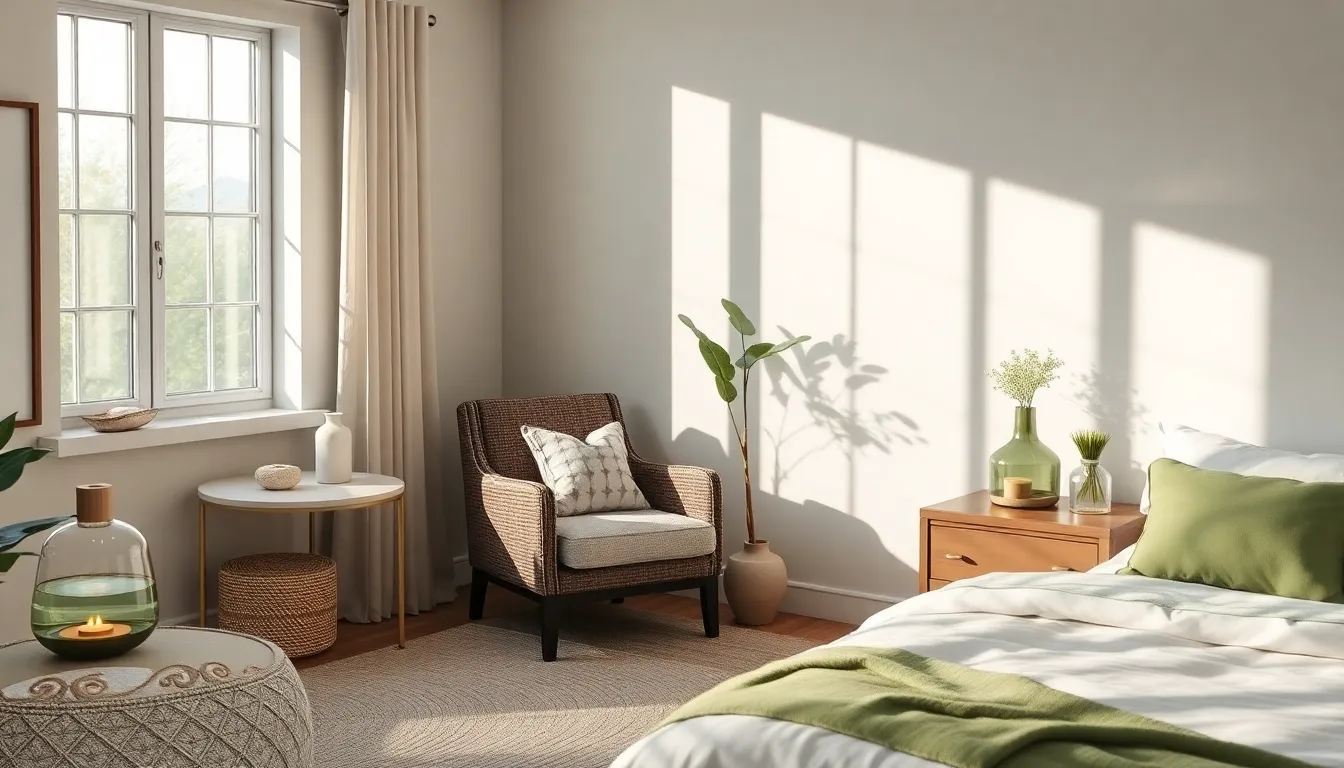
Transforming your master bedroom into a personal spa retreat doesn’t require expensive renovations or professional help. Simple additions like dedicated relaxation spaces and soothing elements can create the peaceful sanctuary you’ve been dreaming of.
Install a Reading Nook or Meditation Corner
Dedicate a quiet corner of your bedroom for reading or meditation to establish your personal wellness zone. Position a comfortable armchair or floor cushions near a window where natural light creates the perfect atmosphere for morning meditation or evening reading sessions.
Create soft lighting around this space using table lamps or wall sconces with warm LED bulbs. We recommend installing dimmer switches so you can adjust the brightness based on your activity and mood throughout the day.
Add a small side table within arm’s reach to hold your books, journals, or meditation accessories. Choose pieces that complement your existing bedroom furniture while maintaining the serene aesthetic you’re building.
Add Aromatherapy Elements and Diffusers
Incorporate essential oil diffusers strategically throughout your bedroom to create a calming atmosphere that engages your senses. Place ultrasonic diffusers on nightstands or dressers where they can distribute scents evenly without creating noise disturbance.
Choose relaxing scents like lavender, chamomile, or eucalyptus that are scientifically proven to reduce stress and promote better sleep quality. We suggest rotating between different essential oils to prevent scent fatigue and maintain the therapeutic benefits.
Position reed diffusers in areas with gentle air circulation like near doorways or windows for continuous fragrance release. These passive diffusion methods work perfectly for maintaining subtle aromatherapy throughout the night without electrical components.
Include Comfortable Seating for Relaxation
Add a plush chaise lounge or oversized ottoman at the foot of your bed to create an inviting relaxation spot. These pieces serve dual purposes by providing comfortable seating during the day and elegant storage answers for extra blankets or pillows.
Select upholstery in soft, calming colors that complement your existing color palette while adding textural interest to the space. We recommend fabrics like velvet or linen that feel luxurious against the skin and enhance the spa-like atmosphere.
Create a mini sitting area using two comfortable accent chairs with a small table between them for intimate conversations or quiet reflection. This arrangement works especially well in larger master bedrooms where you have the space to define separate relaxation zones.
Conclusion
Your master bedroom should reflect your unique style while serving as the ultimate retreat from daily stress. We’ve explored how strategic color choices thoughtful lighting and smart storage answers can transform any space into a luxurious sanctuary.
Remember that creating your dream bedroom doesn’t require a complete overhaul. Start with one element that speaks to you—whether it’s adding layered lighting installing floating shelves or incorporating calming textiles—and build from there.
The key lies in balancing functionality with personal expression. By implementing these master bedroom ideas at your own pace you’ll create a space that not only looks stunning but truly supports your well-being and relaxation needs.
Frequently Asked Questions
What’s the most important element to consider when designing a master bedroom?
The bed should be positioned as the focal point of the room, flanked by matching nightstands for symmetry. Creating proper traffic flow with at least 24 inches of clearance around furniture ensures comfortable movement and accessibility to doors and windows.
How can I choose the right color palette for my master bedroom?
Embrace neutral tones like warm beiges, soft grays, and creamy whites for timeless elegance and a calming atmosphere. Consider adding bold accent walls in deep navy or charcoal gray for visual interest, or incorporate blues and greens to promote relaxation and better sleep.
What lighting strategy works best for master bedrooms?
Layer three types of lighting: ambient for overall illumination, task lighting for specific areas, and accent lighting for decorative elements. Consider statement chandeliers as artistic centerpieces and bedside sconces for reading comfort while freeing up nightstand space.
How can I maximize storage without compromising style?
Invest in custom walk-in closets and modular systems for personalized organization. Utilize under-bed storage solutions, stylish dressers and armoires, and incorporate floating shelves or built-in cabinetry to maintain both functionality and aesthetic appeal.
What furniture pieces are essential for a functional master bedroom?
Choose a king or queen bed frame that fits your room’s dimensions and architectural style. Add functional nightstands that match the bed’s height, comfortable seating like a bench or chairs, and ensure all pieces provide adequate storage for daily essentials.
How do textiles and fabrics enhance bedroom design?
Use high-quality materials like velvet, linen, and silk to create depth and visual interest. Layer different textures through bedding, add multiple pillows and throws for seasonal customization, and include area rugs to define spaces and add comfort underfoot.
What personal touches can make my bedroom feel more intimate?
Display meaningful artwork and photography, create gallery walls above headboards for visual balance, and incorporate plants for natural beauty and improved air quality. Use decorative pillows and throws to introduce color, pattern, and texture while allowing for seasonal updates.
How can I create a spa-like atmosphere in my master bedroom?
Add dedicated relaxation spaces like reading nooks or meditation corners with comfortable seating and soft lighting. Incorporate aromatherapy elements such as essential oil diffusers, and include comfortable seating options like chaise lounges or accent chairs for ultimate relaxation.

